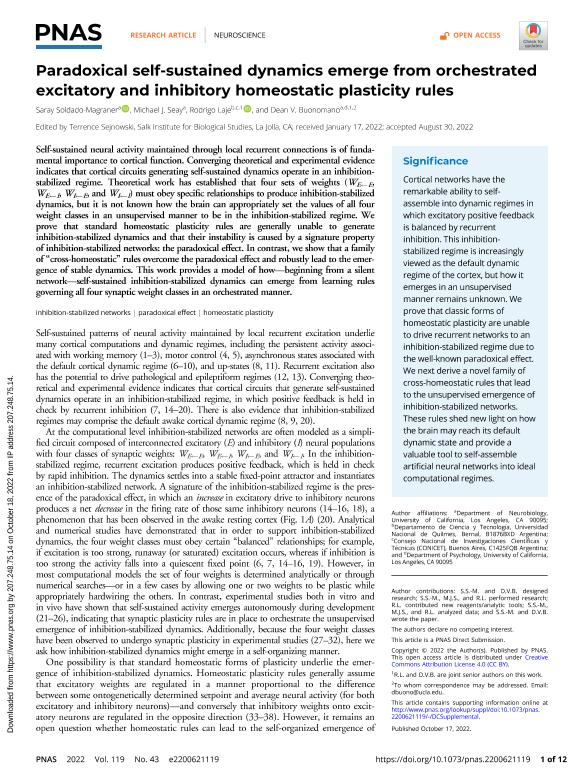Mostrar el registro sencillo del ítem
dc.contributor.author
Soldado Magraner, Saray
dc.contributor.author
Seay, Michael J.
dc.contributor.author
Laje, Rodrigo

dc.contributor.author
Buonomano, Dean
dc.date.available
2023-08-03T12:08:38Z
dc.date.issued
2022-10
dc.identifier.citation
Soldado Magraner, Saray; Seay, Michael J.; Laje, Rodrigo; Buonomano, Dean; Paradoxical self-sustained dynamics emerge from orchestrated excitatory and inhibitory homeostatic plasticity rules; National Academy of Sciences; Proceedings of the National Academy of Sciences of The United States of America; 119; 43; 10-2022; 1-12
dc.identifier.issn
0027-8424
dc.identifier.uri
http://hdl.handle.net/11336/206698
dc.description.abstract
Self-sustained neural activity maintained through local recurrent connections is of fundamental importance to cortical function. Converging theoretical and experimental evidence indicates that cortical circuits generating self-sustained dynamics operate in an inhibition-stabilized regime. Theoretical work has established that four sets of weights (WE E, WE I, WI E, and WI I) must obey specific relationships to produce inhibition-stabilized dynamics, but it is not known how the brain can appropriately set the values of all four weight classes in an unsupervised manner to be in the inhibition-stabilized regime. We prove that standard homeostatic plasticity rules are generally unable to generate inhibition-stabilized dynamics and that their instability is caused by a signature property of inhibition-stabilized networks: the paradoxical effect. In contrast, we show that a family of “cross-homeostatic” rules overcome the paradoxical effect and robustly lead to the emergence of stable dynamics. This work provides a model of how—beginning from a silent network—self-sustained inhibition-stabilized dynamics can emerge from learning rules governing all four synaptic weight classes in an orchestrated manner.
dc.format
application/pdf
dc.language.iso
eng
dc.publisher
National Academy of Sciences

dc.rights
info:eu-repo/semantics/openAccess
dc.rights.uri
https://creativecommons.org/licenses/by-nc-sa/2.5/ar/
dc.subject
HOMEOSTATIC PLASTICITY
dc.subject
INHIBITION-STABILIZED NETWORKS
dc.subject
PARADOXICAL EFFECT
dc.subject.classification
Otras Ciencias Biológicas

dc.subject.classification
Ciencias Biológicas

dc.subject.classification
CIENCIAS NATURALES Y EXACTAS

dc.title
Paradoxical self-sustained dynamics emerge from orchestrated excitatory and inhibitory homeostatic plasticity rules
dc.type
info:eu-repo/semantics/article
dc.type
info:ar-repo/semantics/artículo
dc.type
info:eu-repo/semantics/publishedVersion
dc.date.updated
2023-08-02T17:59:52Z
dc.journal.volume
119
dc.journal.number
43
dc.journal.pagination
1-12
dc.journal.pais
Estados Unidos

dc.description.fil
Fil: Soldado Magraner, Saray. University of California at Los Angeles. School of Medicine. Department of Neurobiology; Estados Unidos
dc.description.fil
Fil: Seay, Michael J.. University of California at Los Angeles. School of Medicine. Department of Neurobiology; Estados Unidos
dc.description.fil
Fil: Laje, Rodrigo. Universidad Nacional de Quilmes. Departamento de Ciencia y Tecnología; Argentina. Consejo Nacional de Investigaciones Científicas y Técnicas; Argentina
dc.description.fil
Fil: Buonomano, Dean. University of California at Los Angeles. School of Medicine. Department of Neurobiology; Estados Unidos
dc.journal.title
Proceedings of the National Academy of Sciences of The United States of America

dc.relation.alternativeid
info:eu-repo/semantics/altIdentifier/url/https://www.pnas.org/doi/10.1073/pnas.2200621119
dc.relation.alternativeid
info:eu-repo/semantics/altIdentifier/doi/https://doi.org/10.1073/pnas.2200621119
Archivos asociados
